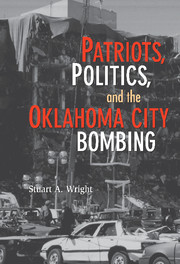Book contents
- Frontmatter
- Contents
- List of Figures and Tables
- Preface and Acknowledgments
- 1 CODICIL TO A PATRIOT PROFILE
- 2 PATRIOTS, POLITICAL PROCESS, AND SOCIAL MOVEMENTS
- 3 THE HISTORICAL CONTEXT OF PATRIOT INSURGENCY
- 4 THE FARM CRISIS, THREAT ATTRIBUTION, AND PATRIOT MOBILIZATION
- 5 STATE MOBILIZATION: BUILDING A TRAJECTORY OF CONTENTION
- 6 THE GUN RIGHTS NETWORK AND NASCENT PATRIOTS: RISE OF A THREAT SPIRAL
- 7 MOVEMENT-STATE ATTRIBUTIONS OF WAR: RUBY RIDGE AND WACO
- 8 PATRIOT INSURGENCY AND THE OKLAHOMA CITY BOMBING
- 9 AFTER OKLAHOMA CITY: PATRIOT DEMOBILIZATION AND DECLINE
- References
- Index
- References
References
Published online by Cambridge University Press: 05 June 2012
- Frontmatter
- Contents
- List of Figures and Tables
- Preface and Acknowledgments
- 1 CODICIL TO A PATRIOT PROFILE
- 2 PATRIOTS, POLITICAL PROCESS, AND SOCIAL MOVEMENTS
- 3 THE HISTORICAL CONTEXT OF PATRIOT INSURGENCY
- 4 THE FARM CRISIS, THREAT ATTRIBUTION, AND PATRIOT MOBILIZATION
- 5 STATE MOBILIZATION: BUILDING A TRAJECTORY OF CONTENTION
- 6 THE GUN RIGHTS NETWORK AND NASCENT PATRIOTS: RISE OF A THREAT SPIRAL
- 7 MOVEMENT-STATE ATTRIBUTIONS OF WAR: RUBY RIDGE AND WACO
- 8 PATRIOT INSURGENCY AND THE OKLAHOMA CITY BOMBING
- 9 AFTER OKLAHOMA CITY: PATRIOT DEMOBILIZATION AND DECLINE
- References
- Index
- References
- Type
- Chapter
- Information
- Patriots, Politics, and the Oklahoma City Bombing , pp. 219 - 232Publisher: Cambridge University PressPrint publication year: 2007



